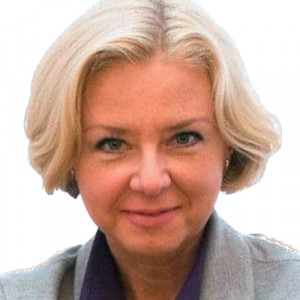The Detector Media NGO has conducted an in-house quantitative study, the Ukrainian Media Literacy Index, which measures the level of critical perception and attitude of Ukrainians towards information and their ability to use the media. The results of the fourth wave of the study, which covered 2023, offer insight into how Ukrainians' media literacy was affected by the second year of full-scale war. The first and second waves of the survey were conducted in 2020 and 2021, and the third wave in 2022 and early 2023.
What were the media literacy index indicators for the Ukrainian audience?
The study results showed that the overall media literacy index level has changed significantly over the past year. The share of the audience with an above-average indicator level decreased from 81% to 76% This is a noticeable decline compared to the previous period, as the media literacy index increased from 55% to 81% from 2020 to 2022.
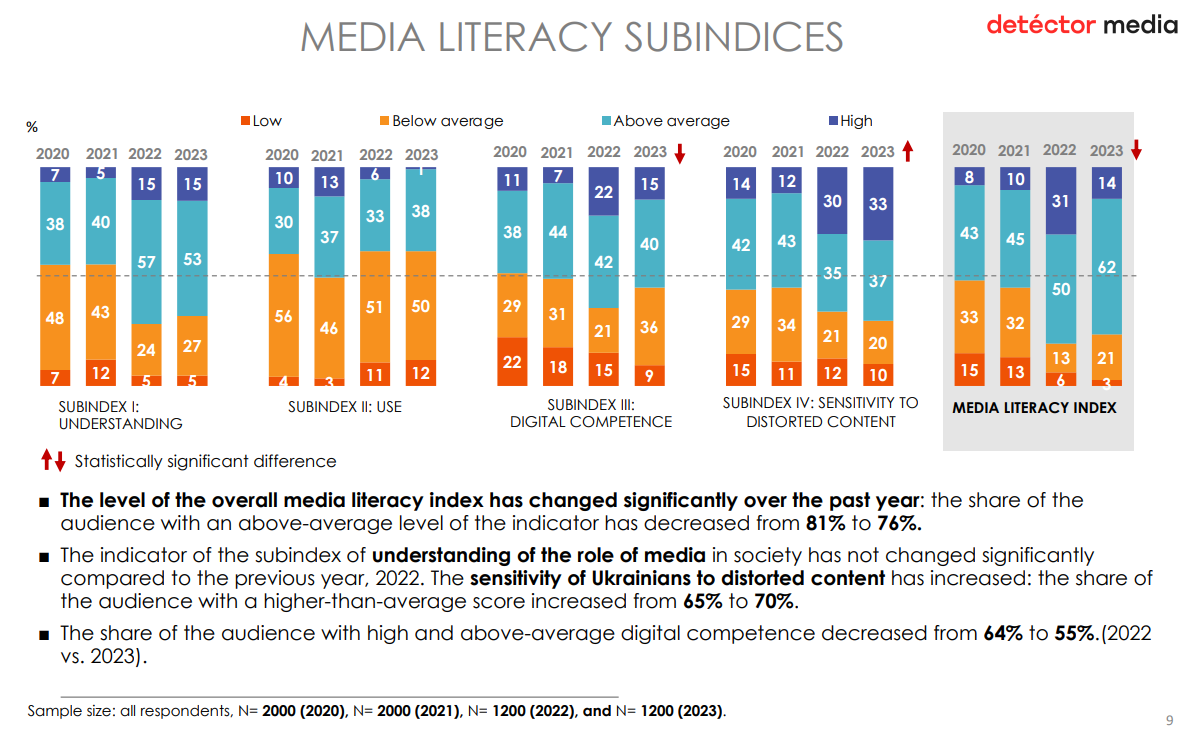
According to the 2023 findings, 3% of Ukrainians have low media literacy (in 2022, the figure was 6%), 21% have below-average media literacy (in 2022, it was 13%), 62% have above-average media literacy (in 2022, it was 50%), and 14% have high media literacy (in 2022, it was 31%).
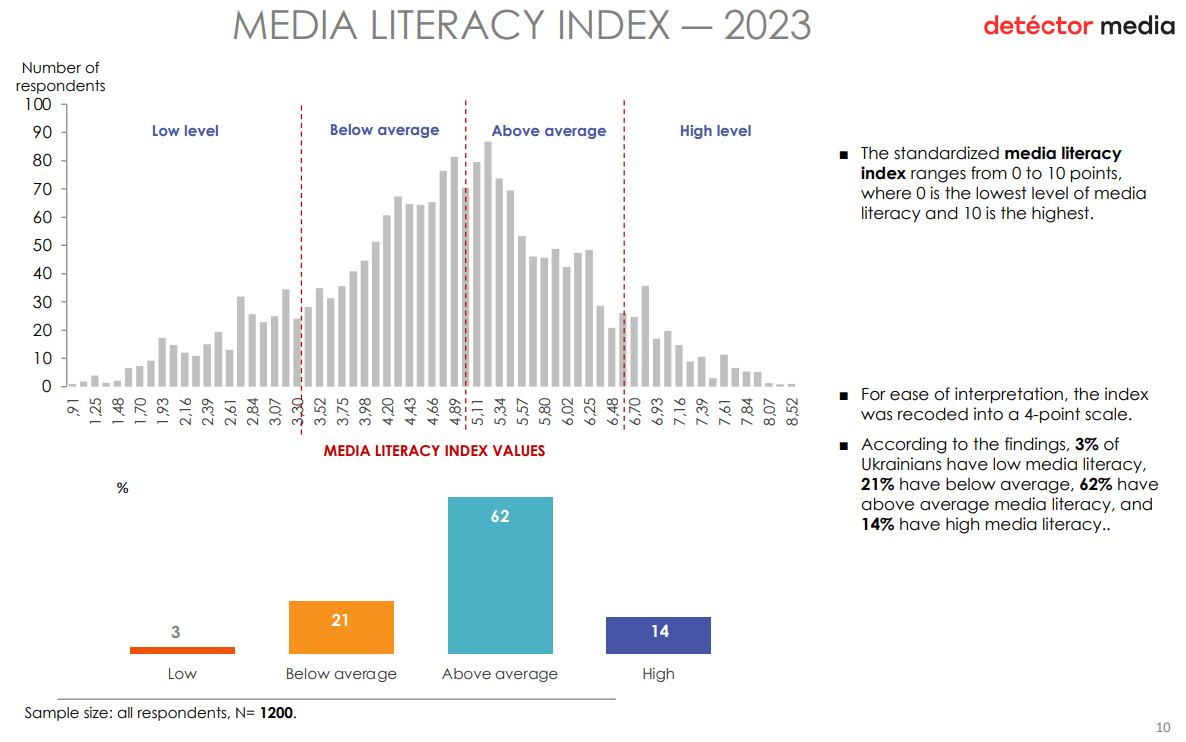
The study also shows that the media literacy level depends on age, level of education, income, and place of residence.
The lower the educational status, the lower the media literacy level. Thus, among respondents with general secondary education, the share of people with low and below-average levels is 29%, and among those with complete/incomplete higher education, it is only 13%. In contrast, half of those with above-average media literacy have higher education degrees. The share of citizens with higher education among those with a high media literacy is even higher at 61%.
As before, a high level of media literacy is demonstrated by young people aged 18-25 (due to the digital competence indicator) and a low level by representatives of the older age group 56-65.
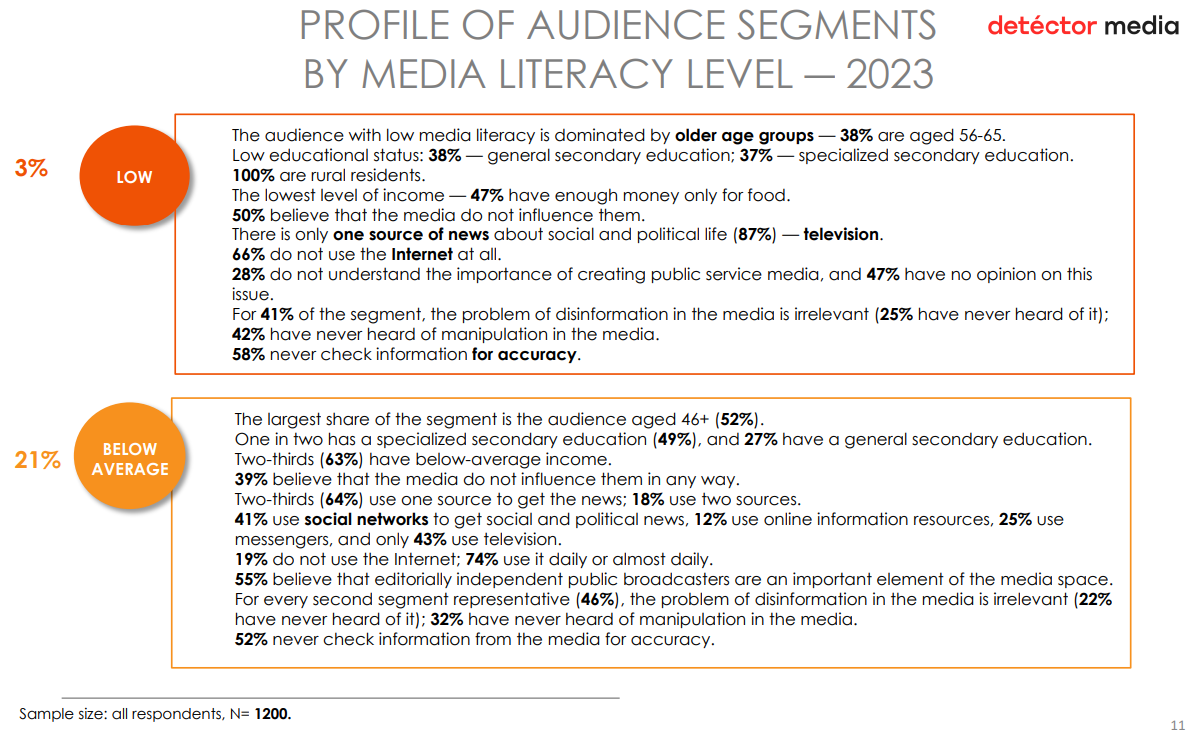
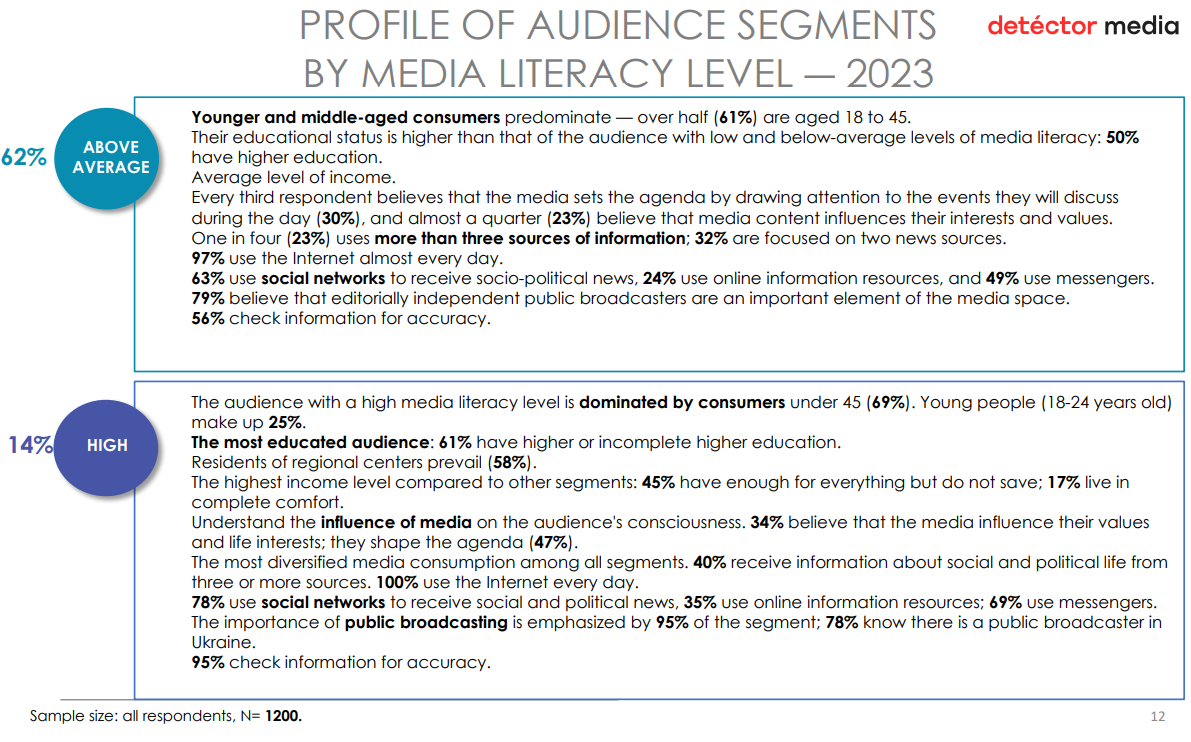
Financial status also has an impact on the level of media literacy. Thus, among people with enough money only for food (low income), 37% have low and below-average media literacy. While among respondents with above-average income, this share is only 18%.
Residents of large cities have a higher index score than rural residents.
Ukrainians' understanding of the role of media in society
The indicator of public understanding of the role of the media has hardly changed compared to the previous year, 2022. The majority of the audience — 70% — believes that the media's main mission is to inform citizens about socially significant events. In the pre-war year of 2021, 54% shared this opinion. Therefore, the study's authors explain the surge in this indicator to 70% by the fact that the main component of media content in the last two years has been war-related messages.
The number of Ukrainians who consider the entertainment function of the media important has halved in recent years, from 25% in 2021 to 14% in 2023. In addition, the share of those who note the impact of media on their emotional state has increased by 11% compared to 2021.

The number of citizens who are convinced that the media should serve as a platform for dialogue between the government and society has hardly changed (36% in 2023 vs. 34% in 2022), as well as broadcast certain values important to society and the government (35% in 2023 vs. 33% in 2022).
Approximately the same share of respondents see the role of the media in educating, teaching, and providing useful information on various topics (37% in 2023 vs. 35% in 2022). Finally, 26% of respondents believe that the media should control the government (last year, the number was 28%).

The extent of understanding of the role of media in society and the impact of media on the audience is also determined by the level of education, income of respondents, and the region of residence. People with high educational status (73%) and income (72%) have a high and above-average level of understanding of the role of media in society. Residents of the western and eastern regions of the country are somewhat more competent. The lowest level of understanding of the role of media in society is among residents of the southern regions.
Perceptions of the media industry and the perception of the domestic media space
The study revealed a decrease over the past year in the number of people who believe that the media work in the interests of the country (from 31% in 2022 to 25% in 2023) and society as a whole (from 15% in 2022 to 12% in 2023). The largest share of the audience (30%) believes that the media works in the interests of their owners and investors. As in the previous year, only 7% of respondents believe that the media serves the interests of their viewers (in 2021, the number was even lower at 4%).

The share of those who consider the telethon format to be fully justified during the war has also decreased from 58% in 2022 to 41% in 2023. 74% of respondents say that due to the lack of different points of view on the events in the telethon, people are looking for information in other sources.
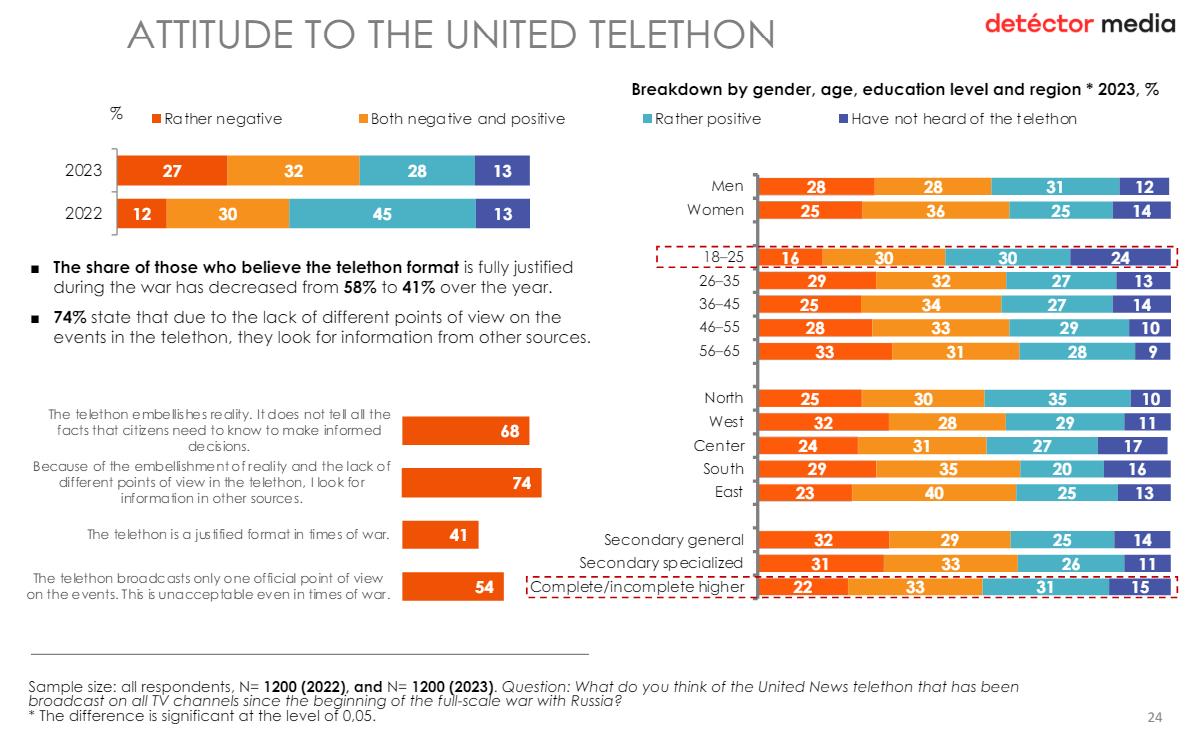
In addition, the study's findings showed that every second Ukrainian (49%) supports criticism of the government in the media. The opposite view is shared by 17% of the audience.
The vast majority of respondents — 76% — recognize the importance of the existence of public service media, as they:
- work in the interests of the whole society, not just the owner (52%);
- cover topics that commercial media are not interested in, such as social issues, culture, and science (9%);
- are not interested in manipulation (15%).
Only 4% of respondents believe that public service media are inferior to commercial media in terms of quality and professionalism.
Audience sensitivity to fake news, ability to identify disinformation, and attitude to manipulation
The study revealed a high level of sensitivity to distorted content among Ukrainians. This suggests that the audience is becoming more competent in identifying fake information. Thus, only 17% of respondents decide how much to trust a message based solely on their own intuition. Last year, this figure was almost the same at 18%, while in the pre-war year of 2021, it was as high as 33%.

The share of Ukrainians who detect disinformation by looking for a link to a source in a story is 37% (in 2022, it was 39%). At the same time, 30% of respondents are looking for video and photo evidence (32% in 2022), and 34% (31% in 2022) are looking for different points of view on an event. For 46% of Ukrainians, a marker of the information's authenticity is its placement in a trusted media outlet (in 2022, the number was 43%, and in 2021, 20%).
According to the survey, the number of Ukrainians who check information for accuracy has increased from 24% to 33% over the year. On the contrary, the share of those who never check media content has decreased from 31% to 26%. In order to determine whether the information is trustworthy, 66% of consumers look for confirmation in other media, 29% assess the reliability of the source to which they are referring, and 25% look for the original source to which they are referring.
The study's authors also note a fairly high level of awareness among media content consumers of the problem of media manipulation. Its relevance is recognized by almost two-thirds of the Ukrainian audience (59%). 15% of respondents consider it irrelevant, and only 14% have not heard of the media manipulation phenomenon. Another 5% of respondents could not decide on the answer.

43% of respondents consider the presence of only one point of view on an event to be a marker of the possible manipulative nature of a media text. For 41% of respondents, this suspicion arises from incomplete or inaccurate information in the message. 37% of respondents admit the presence of manipulation in the absence of references to the source.
Internet use and digital competence
According to the study, only 6% of the audience does not use the Internet. 91% of media content consumers are active online users, accessing the Internet daily or almost daily. This is 3% more than in 2022.
The frequency of Internet use also depends on age, education level, and income. Thus, women (93%) use it more often than men (88%), young people aged 18-25 (97%) more often than people aged 56-65 (75%), and people with higher education degrees (95%) more often than people with primary and secondary education (82%).
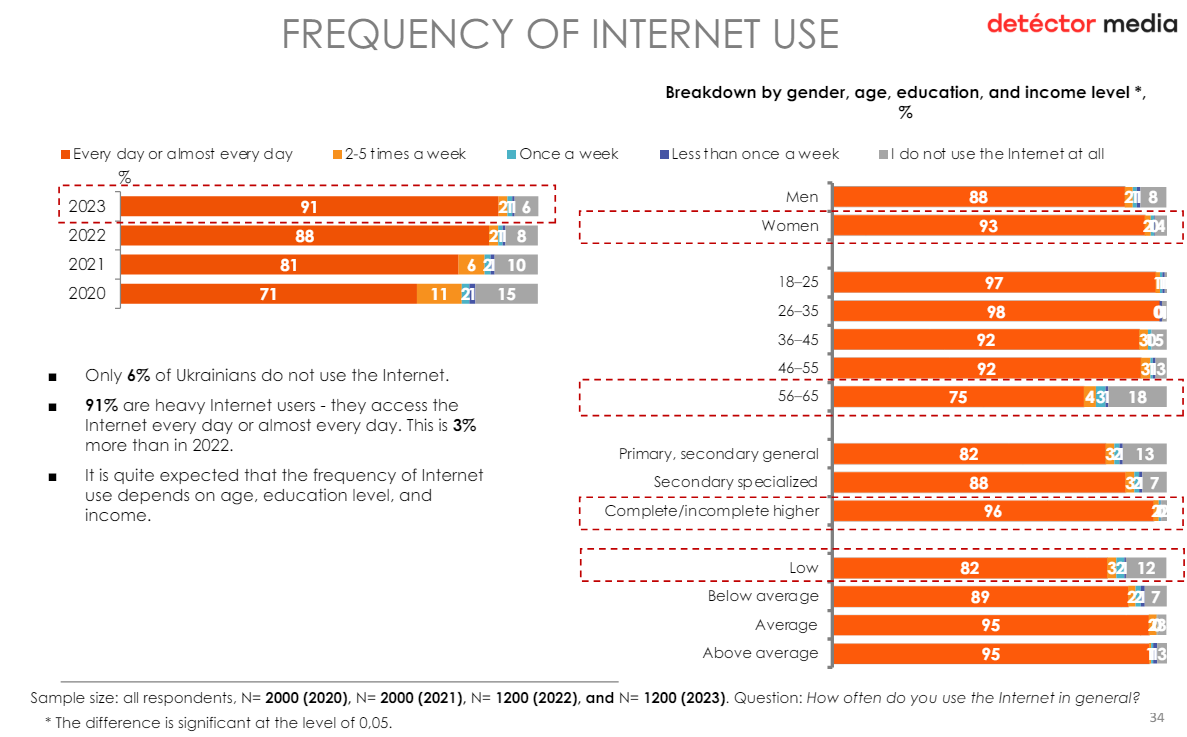
The smartphone is the absolute leader among devices for Internet access, with 96% of the audience using it most often. A laptop (24%) and a desktop computer (10%) are in second place with a large margin. 12% most often use a tablet, and 8% use a smart TV.
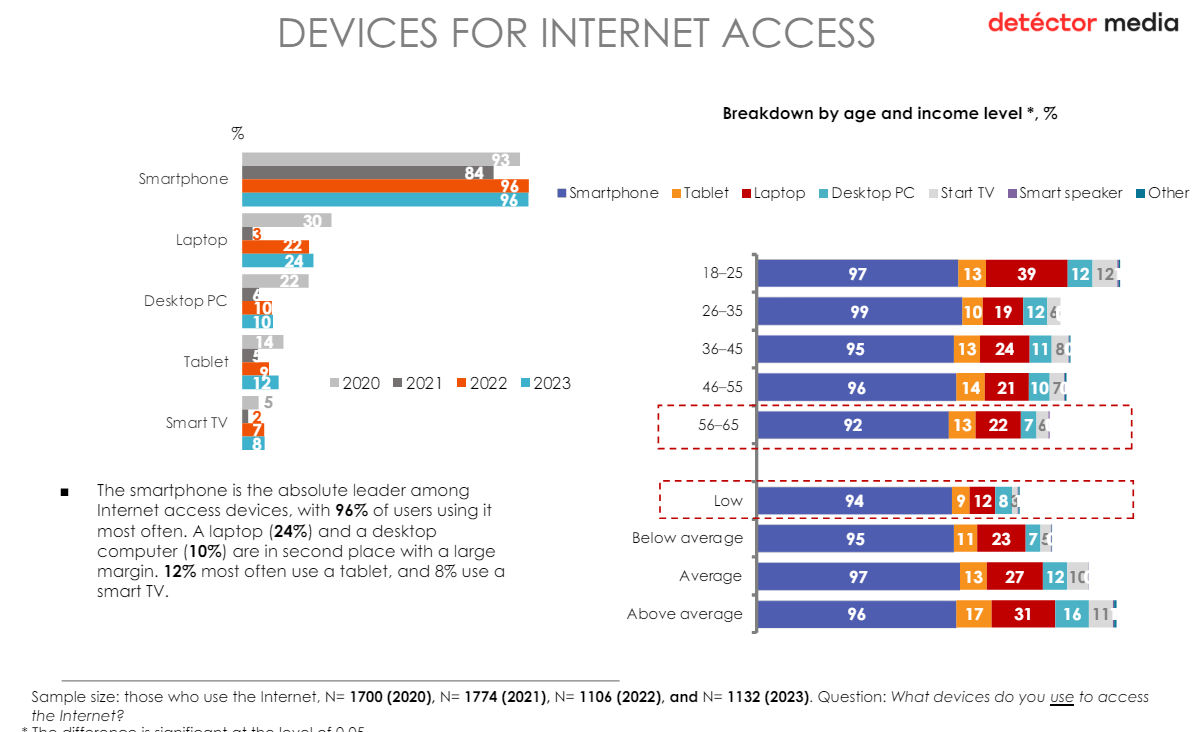
74% of respondents go online to find information, 75% to get the news. Compared to 2022, the share of the audience that uses the Internet for online shopping has increased (34% in 2023 vs. 27% in 2022) as well as for making payments (36% in 2023 vs. 28% in 2022).
The model of the media literacy index was based on the concept of Len Masterman and the results of the qualitative stage of the Practices of Media Consumption of Ukrainians: Conceptual Development of the Index of Media Literacy of the Audience, commissioned by Detector Media NGO (January 2020).
The revised media competence model includes four categories and 42 indicators.
- Understanding: the role of media in society, the depth of media influence on consciousness at the level of frames of perception of evaluation and behavioral patterns; understanding of the media industry and perception of the Ukrainian media landscape; awareness of media regulation, and attitudes towards public broadcasting.
- Use: number of sources of information about socio-political news per week; duration of reading the news per day; motives for using the Internet; devices used by respondents to access the Internet.
- Digital competence: the Internet as a source of news on socio-political topics; understanding of the features and terminology of new media; digital security practices; and the practice of creating one's own media content.
- Distorted media content: sensitivity to disinformation/fakes, manipulative techniques and manipulative media content.
About the study: The Media Literacy Index of Ukrainians was conducted by the New Image Marketing Group (field stage: January 15, 2024 — January 29, 2024). The purpose of the study is to validate the media literacy index concept and calculate it for different categories of the Ukrainian audience.
Methodology: quantitative research using face-to-face interviews with a standardized questionnaire on a tablet (CAPI).
Sample size: 1,200 respondents.
Target audience: adult population of Ukraine (18+).
Sample type: representative in terms of age, gender, settlement size, and region. The survey was not conducted on the temporarily occupied territories of Donetsk, Luhansk, Zaporizhzhia, Kherson regions and in the Autonomous Republic of Crimea
The study was conducted with the financial support of the Ministry of Foreign Affairs of Denmark (DANIDA).


